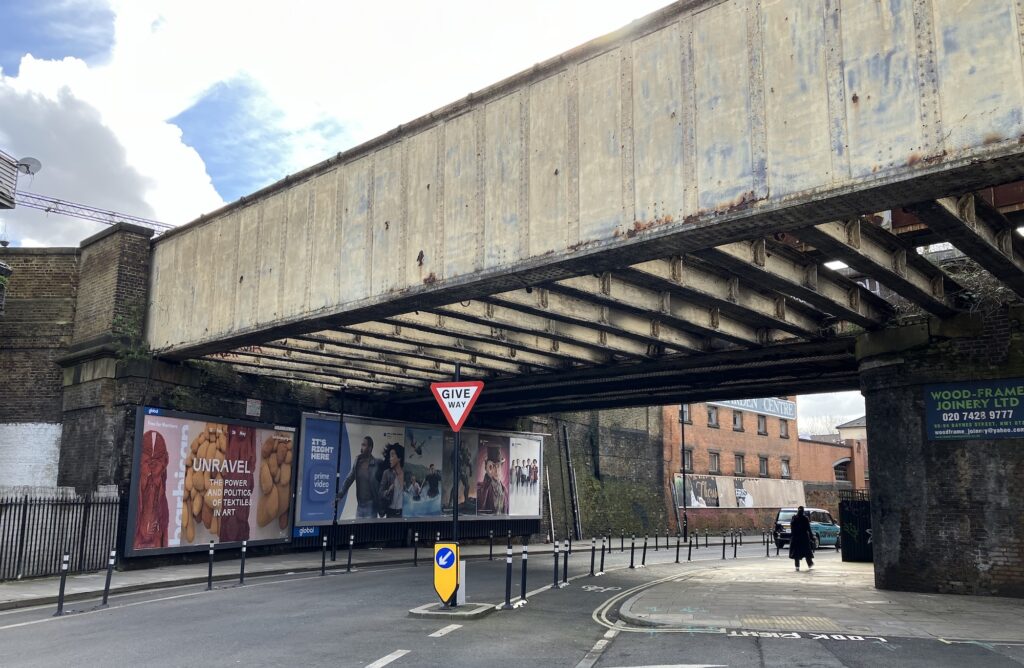When I first heard about the Camden Highline, a £42 million project that hopes to transform a long-abandoned railway track in north London into a green space for pedestrians, I thought it would be a great addition to my old neighbourhood. The New York Highline that runs along the old elevated railroad through Chelsea has proved to be a great success, so why not attempt the same for Camden?
But then I looked more closely at the proposed route and realised that it follows basically the same course as the multi-purpose, and occasionally scenic, towpath that runs beside the Regent’s Canal.

Regent’s Canal and towpath just north of King’s Cross
In fact, the proposed starting point of the Highline in Camden Gardens is just 30 metres away from the access steps to the canal towpath on Kentish Town Road. Moreover, the towpath takes you directly to the sparkling new St Pancras/King’s Cross redevelopment area, while the Highline will head further north to a remoter, uninspiring, section of York Avenue.
If I was still living in Murray Mews (three blocks to the north) I doubt very much I would use the Highline. The track doesn’t go anywhere that isn’t better accessed by other routes, and crucially I would not be able to take my bike on it. Dog walkers will likely be excluded as well. The towpath on the other hand is used by a merry band of cyclists, canines, joggers and pedestrians alike, and traverses a much wider area of north London.
Admittedly, the towpath is dangerously dark and narrow in places and is not always wheelchair accessible, while the Highline proudly boasts open sky and elevators at each entry point making it completely accessible (unless of course you are a cyclist or a dog).
So, what will be the wider benefits of this ambitious undertaking? It is claimed that the Highline will:
Provide a focal point for the local community, acting as a local place to interact on a day-to-day basis, as well as providing opportunities for volunteering and the provision of events… and foster a sense of belonging and ownership over the local environment.
In addition, it is hoped, the development will reduce air pollution, enhance the health and wellbeing of residents, and stimulate the local economy. This might happen if local residents really engage with the project but there is no guarantee they will and there is a danger the net effect will be to create just another tourist attraction like Camden Market with crowds of tourists milling around taking selfies.
One important element to keep in mind, is that the land on which the Camden Highline will be built is owned by Network Rail and the company may want it back at some point in the future when the lease expires. The line has not been used for about 30 years, and it is unlikely that the demand for passenger or freight capacity will suddenly rise but you never know.

A section of the proposed Highline at the end of Agar Grove
That said, the project does have some powerful backers including the leader of the Labour Party, MP for Holborn & St Pancras, Kier Starmer, and the Mayor of London, Sadiq Khan, so if the backers can raise the £14 million needed for the first phase, there is a good chance it will go ahead. Whether or not it ever gets finished is another matter.
However, if the aim of the project really is to foster community spirit and a sense of ownership over the local environment, surely the investment could be better directed at the community groups and services that are already in existence and in desperate need of funding.
In the Autumn and Winter of 2017-18, Camden Council launched a consultation exercise to find out what the local community wanted Camden to look like in 2025. The results focused on the provision of affordable and decent housing for everyone, better employment opportunities, creating safe and vibrant communities, and protecting the borough’s open spaces and cultural venues. The council responded with the Camden Plan, which aimed to implement the suggestions made in the consultation, but like nearly all local councils, Camden is short of funds and many of the key problems are getting worse.
Homelessness is a particularly serious issue in Camden with more than 700 people sleeping rough in 2022-23, the second highest number of any London borough after Westminster. And just to illustrate how acute the problem is, Camden Gardens – the proposed starting point of Highline – was being used by several homeless people as a refuge when I visited the site this week.
With so many pressing issues in the borough, is the Highline really a priority? And is Camden Council really going to evict the homeless for a vanity project?

Camden Gardens. A temporary refuge for the homeless
The leader of Camden Council, Georgia Gould, has publicly endorsed the project but is tellingly relying on others to put up the cash. As she cryptically noted, “the Council is ready to work with those behind the project as it moves forward.”